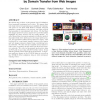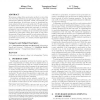MM
2015
ACM
8 years 7 months ago
2015
ACM
We live in a data abundance era. Availability of large volume of diverse multimedia data streams (ranging from video, to tweets, to activity, and to PM2.5) can now be used to solv...
MM
2015
ACM
8 years 7 months ago
2015
ACM
We address the problem of fine-grained action localization from temporally untrimmed web videos. We assume that only weak video-level annotations are available for training. The ...
MM
2015
ACM
8 years 7 months ago
2015
ACM
Establishing common ground is one of the key problems for any form of communication. The problem is particularly pronounced in remote meetings, in which participants can easily lo...
MM
2015
ACM
8 years 7 months ago
2015
ACM
In this paper a discriminant analysis (DA) technique called accelerated generalised subclass discriminant analysis (AGSDA) and its GPU implementation are presented. This method id...
MM
2015
ACM
8 years 7 months ago
2015
ACM
We explore what names people use to describe visual concepts and why these names are chosen. Choosing object names has been a topic of interest in cognitive psychology, but a syst...
MM
2015
ACM
8 years 7 months ago
2015
ACM
Learning image representation by deep model has recently made remarkable achievements for semantic-oriented applications, such as image classification. However, for usercentric t...
MM
2015
ACM
8 years 7 months ago
2015
ACM
Crowdsourcing is a popular tool for conducting subjective evaluations in uncontrolled environments and at low cost. In this paper, a crowdsourcing study is conducted to investigat...
MM
2015
ACM
8 years 7 months ago
2015
ACM
Music consists of several structures and patterns evolving through time which greatly influences the human decoding of higher-level cognitive aspects of music like the emotions e...
MM
2015
ACM
8 years 7 months ago
2015
ACM
We propose a data-driven geolocation method on microblog text. Key idea underlying our approach is sparse coding, an unsupervised learning algorithm. Unlike conventional positioni...
MM
2015
ACM
8 years 7 months ago
2015
ACM
Every culture and language is unique. Our work expressly focuses on the uniqueness of culture and language in relation to human affect, specifically sentiment and emotion semant...


